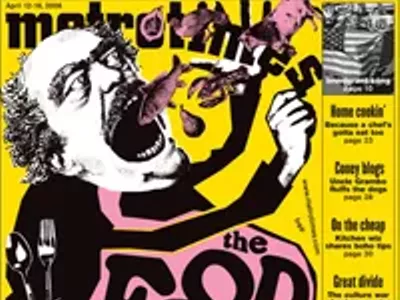Red state, blue state. Letterman, Leno. Prius, Escalade. ... You probably know where you stand. But have you taken a side in one of the most potentially polarizing debates á la mode: cake or pie? Perhaps you think there's already enough separating you from your neighbors. Why add baked goods to the mix? Why cake? Why pie? After all, it's only dessert — right?
Wrong. The sweet you eat alongside your post-dinner coffee may say more about you — and your worldview — than you care to admit. And likely it's less a rational choice than an innate inclination. Even the most evolved, open-minded gastronomes tend to go with their gut on this one. But what does it all mean?
They say nothing's more American than apple pie, but other flavors come close. The first pie, which was originally called a "coffin" because of its sealed floor and lid, first wedged itself into our national identity when the pilgrims and Indians gave thanks over a humble round of pumpkin. And Laura Palmer's mourners will recall how agent Dale Cooper swallowed Twin Peaks cherry slices to soothe his troubled soul, reflecting, "This must be where pie goes when it dies."
Meanwhile, cakes are baked, rum-soaked and spiced. Flourless and molten. Draped in red velvet. German. It's the devil's food. And we all know Marie Antoinette's heartless position; she advised her bread-starved subjects to simply eat cake when hunger pangs struck.
But we may be mistaken when it comes to issues of cake and class. Historians now agree some other grandee said, "let them eat cake" — or, properly translated, "let them eat brioche" — decades before Queen Marie lost her head. And according to The Joy of Cooking, German chocolate cake is not even from Germany — a Texas hausfrau apparently first published the recipe for a cake she baked with the sweet chocolate of Mr. Sam German.
However, though far removed from cake's aristocratic pedigree, the Texan creation holds no candle to the "cake" you can make by mixing a 12-oz. can of Coca-Cola (diet or regular) with any packaged mix. As a Mr. Wizard-type chemistry experiment, it works — just skip the eggs, milk and oil, and bake as directed; as a cake, it tastes like it was cooked over a Bunsen burner. But despite its many battered permutations, cake remains a staple for les loyalistes de gâteau.
With all this frosting and circumstance, it's no wonder some prefer the mom-sanctioned pie, a more straightforward assemblage of fruity filling and flaky pastry. What is it about pie that makes it an American standard? Does our appreciation stem from an appetite for more homegrown ingredients? Or is it pie's utilitarian origin that appeals to so many Americans? After all, back in the 12th century, the crust was purely used as a vessel to transport more interesting ingredients to the working fields (just like they did way back in Egypt in 2000 B.C.). The flour and suet paste was baked hard beyond edible. Later attempts to gussy pies up as tarts can't hide those humble beginnings.
But just how divisive is dessert? An informal survey of informal diners recently revealed a fairly even split between the cake connoisseurs and the patrons of pie. It seems that for most, the choice is clear. When they cut into their confections, they know if they'd rather find dancing girls or four and twenty blackbirds.
Some independents, however, see the issue as layered. They fight for the underdogs, "What about strudel?" they demand. "Have you considered the flan or baklava?" "And don't forget doughnuts!" They may have something. What is the point of separation? Is the crux the leavening egg or a crusty enclosure? Could a concoction like cheesecake sabotage any attempt at classification?
Most importantly, where is our middle ground? What is the sweet spot in between pie and cake where everyone can get their just desserts?
Erin Eisinger Katrincic and Kate Muth are arbiters of taste. They live in New York City. Send comments to [email protected]





